Does no-till gardening work on clay? Or concrete-like ground that fails to let water through?
Elizabeth shares her story and solutions in my latest video:
Elizabeth’s Story of No-Till Gardening on Clay
Elizabeth is a fit, strong woman with endless enthusiasm. I headed to her garden with my camera to learn what I could about her experiences with improving the hard, airless, poor soil in our area of Alabama.
She stands in the middle of a fenced-in garden, surveying her domain, and I start the recording.
“So we cleared all of the trees in this area and were left with just a whole bunch of baking dirt,” Elizabeth says. I have seen the soil outside her garden, so I nod. It is horrible, hard stuff.
“And we came in, this was about two years ago, came in and put straw on top, or hay on top. And when we finally moved out to this property, we started putting wood chips on top. And so we’ve had two years of wood chips sitting on top of the native clay.”
“So in all of my learning, I’ve been very excited about deep mulching, no-tilling, working on the microbiology in the soil. I’m a big believer in the microbiology in our gut, and I feel like it is mirrored – that plants will be healthier if there is a good balance and a good population of bacteria in the soil as well. So along those lines, I have not tilled and I have mulched, but the mulch is sitting on top of hard pan clay. So when we go without rain, which is rare because we get more rainfall here than in, I believe, any other place in the country. When we have those wonderful moments where there isn’t rain, the garden is the best ever, and each season it gets better and better. And yet when we have our weeks of rain, every day, I can come out here, stick my shovel three inches down, and there is a pool of water and the plants just die. So I’ve really been battling that hard, hard impenetrable clay.”
She breaks up a piece of the ground with a braodfork to show what is happening beneath the surface.
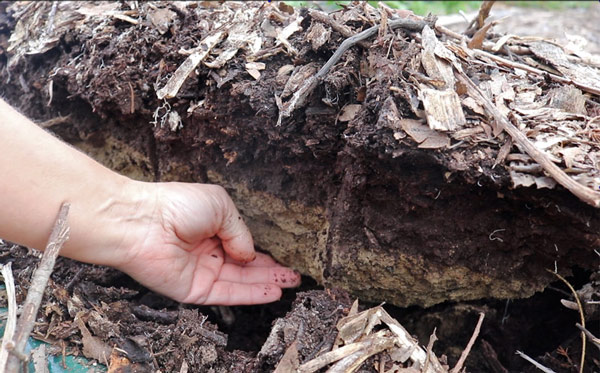
“So it was time to harvest the sweet potatoes, which I’ve been using in the walkways as a ground cover, and a tilling device, and a livestock feed, and food for us. And it’s been great. So it was time to harvest the sweet potatoes, and David loaned me his broad fork, and for the first time ever I was able to go 14 inches down into the ground. And when I would try to lift up, I realized I had this beautiful, beautiful layer of decomposing mulch, and nothing could penetrate it. And so as I lifted up I realized it would take decades, I think, for my plants to break through that brick. And so I am now using the broad fork to mix in some of my surface organic matter, and just break apart that clay, so that I’ll have 14 inches at least that the water will be able to drain down, the nutrients will be able to get down, and the roots will be able to get down, so that hopefully that will expedite turning my clay into living soil.”
“So you can see all of the compost decomposed, but then nothing’s getting through there.”
“How long would it take for roots to penetrate this?”
“I was told, ‘Oh, use daikon radishes. They will drill through that clay.’ So okay, I’ll give it a try. So here we have a daikon radish and it’s going through my mulch. Isn’t that wonderful. Look at that. No till. Wonderful, beautiful. But then let me use the broad fork and let’s see if it made it into the clay. It never made it to the clay.”
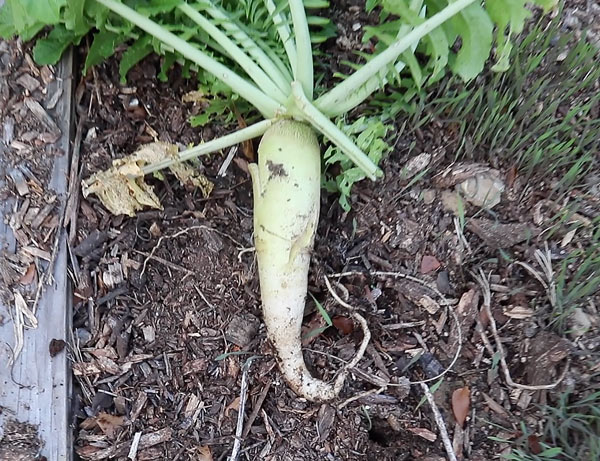
“It would have hit and bounced off. (Yet this soil on top) is fantastic.”
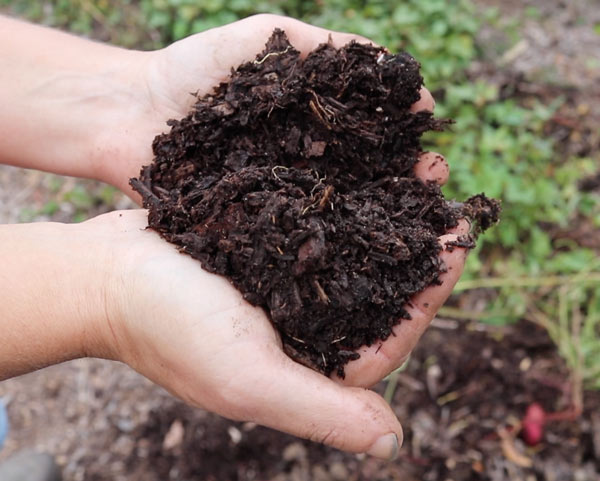
“This is what I wanted, and I thought that the worms would mix it all in for me, but nothing can get through (the hardpan layer). So I’m going to broad fork and mix in my living organic matter, allow biology to begin working at least in 14 inches. And when I broad forked this morning and really mixed things up, I then covered it with wood chips so that I’m not exposing all of the biology to the sun and the elements and whatnot. So I’m hoping to have a combination of a no-till philosophy, but I’m having to till to get through my brick layer here.”
“I wanted you to come see this, because in looking online and reading books I hear about all these different methods, and I want to try them. And part of the fun to me is not just getting the produce in the end, but to see how things work. This is just a big science lab to me. And so I wanted you to come see and be able to show people that in this situation, this is how the deep mulch has worked. It has given me more productivity, more life than I think I would have had if I had just tilled this soil, or this dirt, this clay. And yet, it needs to be amended a little bit. My plan needs to be amended. And to me, this would be an educational experience for people to see what the deep mulch does in this situation.”
“I’ve been really excited about what sweet potato does in the walkways as a ground cover. So here I am. I’m mulching, I’m not tilling. Or at least I wasn’t until I got this broad fork and learned what the situation is deep down below. But having planted all of these sweet potatoes in the walkways, my intention was that the roots would send sugars down into the ground, microbes would like it, I’m suppressing weeds, I have greens to eat, the pigs have greens to eat, and oh at the end maybe we’ll get some sweet potatoes. Maybe we won’t, but who cares? It’s a workhorse anyway. So I simply took the slips that grew up out of the ground, I cut them. I stuck them down in the ground and I walked on them all year long and they did a wonderful job.”
“I think I’d like to make a shirt that says, ‘stick a fork in it.'”
“We can see the sweet potatoes, I believe, like the daikon radish, went to my hard layer and stopped. And over here, you can see my nice mulch and my hard layer that really nothing much gets into.”
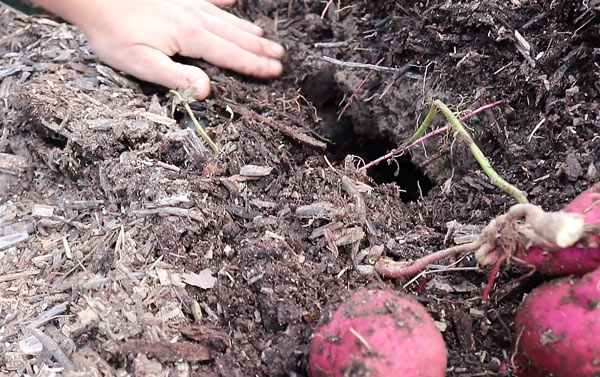
“These roots, I think, were growing up in the mulch layer, not going down into that hard clay. So I thought that I was just going to come in and harvest sweet potatoes, but the broad fork has taught me I need to go in and actually break up 14 inches deep, break up some of this clay. But again… it hits the hard dirt and it’s done.”
“So what I did today was I deep forked this area. I got 14 inches down, pulled up, tried to break up the clay, let some of my mulch and biology get down in there. I then also forked in some chicken run dirt. We put our bags and bags of leaves, the chickens they’ll add their manure, and they will compost those leaves for us and turn it into leaf mulch. So some of that went in here, and then I covered it with wood chips so that it wouldn’t be exposed to the elements. And I can now plant my seedlings in this area. And I’ve learned, so far since we’ve been at this property, and trying this garden for two years, I’ve learned that I don’t do very well direct seeding. I think those rains come, the biology, the worms, the cutworms, they all come up out of the swamp and they eat anything. Or maybe they’re just hanging on for dear life. I don’t know. But direct seeding is not working as well for me. Although this season, I’m doing better with direct seeding than I have the previous two years. So it’s coming.”
“In the walkways, I’m sold on sweet potatoes, early summer, late spring, going ahead and putting slips in the walkways. And then when I harvest the sweet potatoes, I plan to put the winter rye in. And when it starts to get too tall to walk on, I can just mow it or whatever. That’s going to get good roots in there, sugars in there, organic matter, and winter rye is supposed to roots really, really deeply. Maybe that will help me with my clay, and then when it’s time to terminate it, I can mow it and I can stick my sweet potato slips in there again.
The pigs will eat what’s above the ground, the pigs will eat what was under the ground. And then I get to eat the pigs.”
“It really works. It’s beautiful,” Elizabeth says, holding a handful of beautiful humus. “And I think if it weren’t sitting on top of a paved road, that is essentially what I feel like that clay is, I think it would work really well. So if we can break up the clay and let this continue to go deeper and deeper, I think I’m going to really be able to garden.”
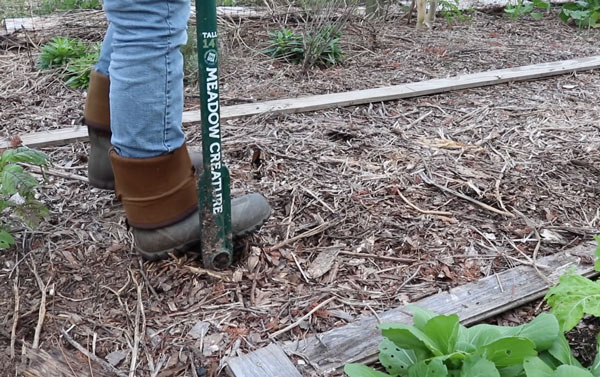
“So while we were clearing the land to prepare to build and to make room for the garden, they cleared all of the trees. And we were not able to come in immediately the next day and cover the soil. So the hard clay that you see when I put my broad fork down in the garden, this is exactly what it was two years ago. And so at the very least, my mulching has given me a nice layer to grow in, and it has prevented this from just getting harder and harder and harder.”
“(These sweet potatoes are just what) I harvested from the northern half of the garden.”
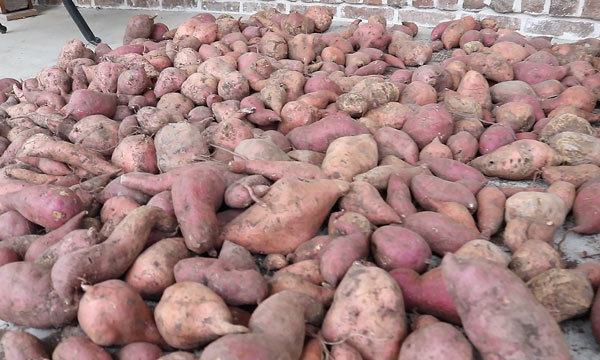
“What you saw before on the other porch was from the southern part of the garden.”
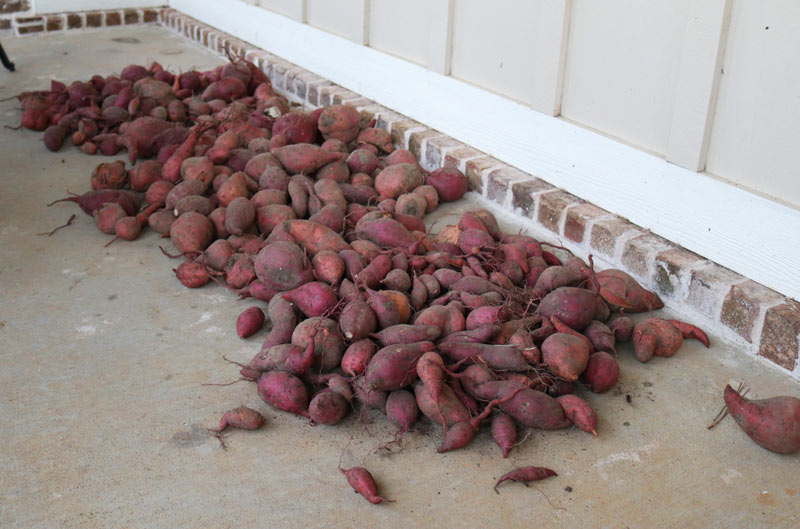
“And the intention was not really to get sweet potatoes. The intention was just to cover my walkway so I didn’t have to weed them, and to break up the soil!”
“If I were to start a garden right here,” Elizabeth says, waving towards a piece of untouched bad ground, “with the experience that I have gained over the past two years, I would come in and I would broad fork this area. I would add compost or some sort of organic matter, manure would be super, but you need some organic matter forked into it, and then I would immediately cover it. And I think that would just be a wonderful way to get started. And once you’ve established that, I can’t help but think that you just continue to mulch, and your plants will feed your soil and your biology that’s in the soil. And you can use the crop residue to continue to mulch as well.”
My Final Thoughts on No-Till Gardening
Don’t be afraid to dig into the gardening tool kit if your favorite method isn’t working. Experiment like Elizabeth and see what works. Ideological purity is no way to grow food, son. Especially in these uncertain times. No-till gardening may work great in some situations and not cut it in others. Don’t be afraid to change tactics.
Fail fast and learn as you do until you find success.


9 comments
No till is the ideal. But one has to realize that we don’t live in an ideal situation and, while given enough time, it can work, we may not have that time. So speeding things a bit to feed your family is not a bad thing. The damage is too great at this point to be reversed within a single generation, at least in most places in the industrialized countries. So we have to help nature. Waiting for fertility to come back on its own will not work.
Thank you for this post. We’re moving to property we own in West Virginia this year. The “soil” is clay, clay, clay. I really want to do no-till, but I’ve been thinking about doing doing some tilling to get things mixed in. No matter how I go about it, improving the land will be hard work, but I love this place. It’s been in my family since the 1840s and I’m willing to put the work in.
Thank you for your iconoclast style. I deeply appreciate it in the world of “do this, do that.”
All things in moderation is an excellent approach. That said there are ways to create excellent, healthy, new soil in one season. “Grass” clippings are free and keep erosion down while turning back into top soil themselves. I use quotation marks because I do not spray the “weeds” in my lawn and haven’t for over 30 years. You don’t want to put things on your gardens that have gone to seed, but if you are keeping your “lawn” down, that is highly unlikely. It can be done with lawn mowers, push mowers or even with a scythe. We just need to start rethinking everything pushed on us commercially, and even, in some instances, traditionally and we will find we are often discarding the very things we need. Leaves and weeds we pull out of our gardens as well as grass clippings are prime examples. Fallen trees and tree limbs… theses are the slow release fertilizers we can use under new beds or in the bottom of containers or as supports in our gardens.
My most recent approach, especially with the Grazon issues in recent years, is not to bring in anything for my yard and garden as much as I can help it. Nothing in a plastic bag, no hay or straw, no powders that are supposed to be fertilizer, etc… We all create enough green and food waste to replenish our own soil if we do not kill the microns with chemicals, including chemical fertilizers.
Good plan!
Hi, Natasha – you are not supposed to disturb GOOD soil. If it is clay, clay, clay it isn’t good soil and you can dig it up to your hearts delight, even using a machine to make the work easier and it is not too expensive to get it done. However then you should have your compost game in place to mix it up. If Elisabeth in the story of David had known that the assumption of top down softening her clay in combination with high rainfall did not work she could have spared herself a lot of work. I read a comment of a woman from Iowa. Sunny summers, but also good rain. Organic coarse wood chips, hard to get so she stocked up, but had them outdoors. Clear plastic bags that drew water (maybe she was sloppy or the bags are a material the is made to break down fast. She claims that the wood chips were broken down in 2 months. if that works that would be a fast way to get good substrate. likely it does not have a lot of nutrients, but it is not going to draw nitrogen either (that phase is over, I guess the fungi in the bag were able to do without, or the can draw nitrogen from the air – if they must. (so not in soil when they can get it).
If you can get your hands on wood chips, the clear bags would not cost that much, they likely hold for a time. And of course spent mushroom soil.
Anyway that stuff could be could to be intermixed with clay that you break up. And maybe perlite ?
I also saw videos where lawn enthusiasts drill long tunnels into their lawn to aerate it (they fill it up with organic stuff – so that there is air, moisture and food for soil life and worms.
Even that could be worth a test – if it is about a garden, can’t do it for a larger area.
Good luck with your new property.
To clarify – after the first big turnover you likely could do no till. The soil – if it even has life in it – will have to recover, but you can nurture it from there.
I also read an interesting comment that a little clay is crucuial for the ability of soils to hold water and that they add to the specific taste of fruits (for instance that is well known in vineyards).
If no deep tilling is done – not even when you set up your system the soil misses out on the contribution from deep down, and it shows after 15 – 20 years (that was the claim). I cannot assess the merit of that statement, the argument sounded interesting and the commenter seemed knowledgeable. I think if a clay soil is improved, the water retention ability can become a very valuable asset, and like also the ability to provide minerals.
Karen, you can bring up nutrients using vegetation with deep tap roots, like comfrey, and do chop and drop to make it available to trees, shrubs and plants. Cover crops like buckwheat and legumes give you green manure, grains for the family and animals, straw for mulch or animal bedding, etc…while pulling up phosphorus and making it useable to other plants and enriching the soil with nitrogen and many other minerals.
Here I found it, from a user Alexandre Lollini * ….Clays are needed, in little quantities. There are two kinds of clays, one is in a sense of granulometric sizes (the smallest particles) then there are organic and mineral clays. The soil need all kinds, but the clays are better deeper in the soil (under compost) composting create, in the end, organic clays. Big trees are breaking rocks into mineral clays with the help of fungi. At some point when you have deep organic soil after years of composting and wood chips decomposition, at depth a lack of mineral clay can be observed. The opposite of compacted clay soil, witch is bad. When digging a hole to plant a tree, the bottom mix must include a little mineral clay, well mixed, then a mix dominated by compost for the upper part, then mulch on top. Both clay compacted soil only and organic compost only soils are bad, you need a balanced soil different at different depth. To combat compacted clay soil : ONE initial tilling (it’s not tilling, it’s uncompact soil, ONCE) to mix with compost can be needed, if you can’t wait 10 years for deep roots of trees to do the job. Clays both organic and mineral being the finest particles, are the most important keeping moisture the longest, offering the largest surface area of exchange with air and gases. Annuals can’t break into compact clay soil. Only organic soil do not provide some minerals. Mineral clays play a huge role in grape taste (for wine especially) There are people with soils that are only rocks and compact clays too, and this is an issue important to address FIRST.
I found that an interesting comment in a video from Nov. 2020, James Prigioni, it’s time to clear things up, the truth about the back to Eden Method.
Hope it helps
Very interesting about the clay. Thanks for sharing that. We have about a foot and a half to two feet of rich black soil, then clay.
Comments are closed.